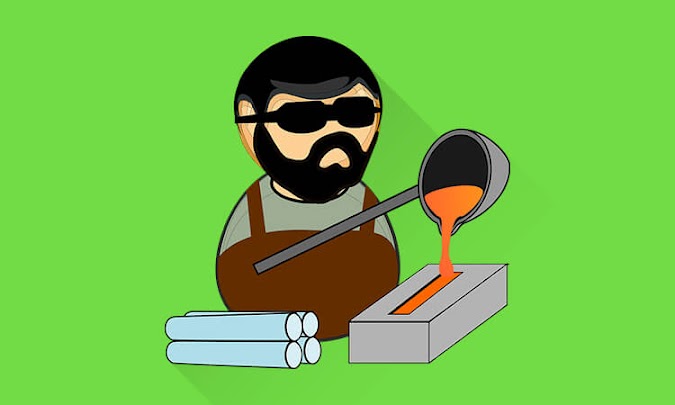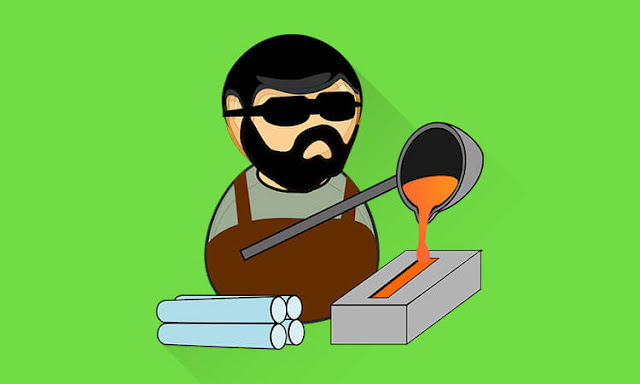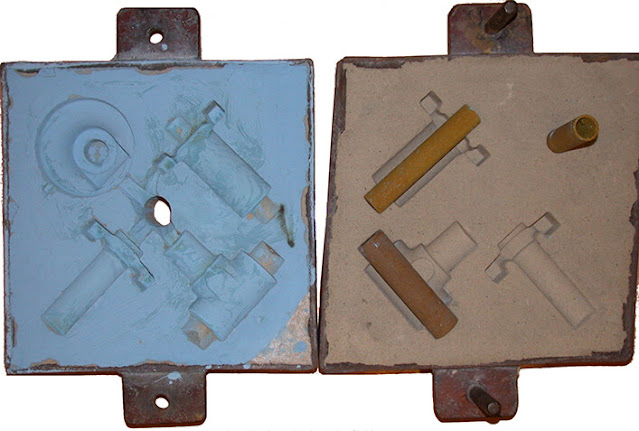Types Of Mould Material - Green Sand, Dry Sand, Skin Dried, Loam, Metal Mould
Mould is a cavity of heat resistant material used in metal casting. According to the material used mould is classified into the following type
- Green sand moulds.
- Dry-sand moulds.
- Skin-dried moulds.
- Loam moulds.
- Metal mould.
🔗Terms Used In Casting Process
Green sand moulds
Green sand mould is the most common type of sand mould. Green moulding sand is a mixture of sand, pulverized coal, bentonite, water, and other material. It is called “green” because of the presence of water content. They are used for making grills, weights, moulding boxes etc.
Advantages and disadvantages of green sand moulds
Advantages
- Green moulding is cheap.
- No limit on shape, size, weight of mould.
- No backing operation and equipment are needed, so it is less time-consuming.
- Great flexibility as a production process.
- Green sand mould can be used to cast all types of ferrous and nonferrous metal.
- After the casting is solidified, the mould and the casting can easily be separated.
Disadvantages
- Since it is not strong, the green sand mould cannot be used for complex casting shapes.
- Green mould is not very strong; it may get damaged during handling. Also, it cannot store for a long period of time.
- The moisture present in moulding cause defect in certain metal casting.
- Low dimensional accuracy and surface finish are not up to the mark.
🔗Properties of Moulding Materials/Sand
Dry-sand moulds
Dry sand moulds are made of drying raw sand; it does not require moisture to develop the strength. Some binding resins are used for strength. These types of moulds are usually used in steel casting. Used for making parts like larger rolls, gear housing etc.
Advantages and disadvantages of dry sand moulding
Advantages
- Reduce the defect caused by moisture.
- Dry sand mouldings are stronger when compared to wet sand mould.
- Better surface finish.
- Fewer defects and better dimensional accuracy.
- More permeable than green sand moulding.
Disadvantages
- Comparatively, it is expensive.
- Compared to green sand moulding, dry sand moulding production is slower.
- Processing time is greater than green sand moulding. So they are not suitable for mass production.
- Because of baking, there is a greater distortion
- Castings are more prone to hot tearing.
Skin-dried moulds
As the name suggests, the skin layer of this mould is dry. These are the mould with dry sand facing and green sand backing. Since it has green backing, it is less expensive when compared to dry sand mould. But it is not strong as a dry sand mould. Skin-dried mould is the most commonly used type of mould for large casting. This type of mould is used to cast both ferrous and nonferrous alloys.
Loam moulds
Loam moudlding is adopted when large casting does not fit regular box mould. Loam sand is a mixture of sand and clay; it also contains fire clay or ganister. The mould-made with loam sand is known as loam mould. In this type of mould, the rough contour of casting is made with porous bricks, which are cemented together with load mortar (or skeleton pattern). The inside of the brick structure is then faced with a 6 to 12mm loam sand layer to give the required shape. After preparing the mould, it is baked by using forced hot air.
Loam moulds are used for large casting. They are suitable for moulding of domed, cylindrical or conical shapes like cylinders, large bells etc. Loam mould requires plenty of area and space; it is also difficult to give proper contour and shape. So, they are suitable for single casting.
Metal mould
Metal moulds are permanent mould. Metal moulds are used in the die casting of alloys having low melting temperatures.
Advantages and disadvantages of metal mould
Advantages
- Long life
- It does not eroded when pouring molten metals
- Improved surface finish. The casting produced by metal mould gives a very smooth surface. So, much of the surface finishing process can be eliminated.
- Casting produced in the metal mould is less defective.
- High production rate.
- It can be used for casting thin sections.
Disadvantages
- Specially skilled labour is needed for the maintenance of metal moulds/equipment.
- High-cost mould and equipment.
Some other special moulding types are shell moulding, CO2 moulding, cold box mould




